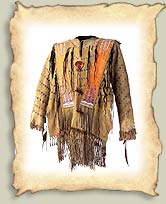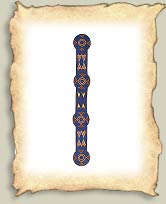|
|

How we lived with the Land
Wintering Ground
When the cold weather came, our people moved into sheltered coulees and river valleys and into the foothills. Here, they were close to water and a plentiful supply of wood to burn in their tipis. If the blizzards covered the grass with snow, the bark of poplar trees was fed to the horses. |
|
|
 |
Making Clothes
It was often too cold to tan hides during the winter. Women used this time to make new clothes.
Boys and girls outgrew their shirts and dresses. Men and women wore out their clothes. The hard ground wore holes in our moccasins. Women were proud of their skill at making and decorating clothes. Often designs were passed from one generation to the next in a family. To learn more about the roles of men and women, please read the story of the Wolf Trail.
 |
![R.B. Nevitt, Untitled [woman doing her sewing], ca.1877, Collection of Glenbow Museum](../../images/camp07_making_clothes_img.jpg) |
R.B. Nevitt, Untitled [woman doing her sewing], 1877, Collection of Glenbow Museum
|
| |
|
 |
|
 |
Sewing
Bones and pieces of metal were sharpened at one end to make awls. These were used to make small holes in the hide. Our women used sinew as thread, pulling it through the holes to sew pieces of hide together into shirts, dresses, and moccasins. These awls were very important and were kept in special cases.

|
 |
Collection of Glenbow Museum
|
 |
|
 |
Quillwork
Porcupine quills were collected, dyed, and woven into intricate designs. This work could only be done by women who were given the privilege of working with quills.

|
 |
Collection of Glenbow Museum
|
 |
|
 |
Man's Shirt
Dyed porcupine quills were woven into designs on shirts. These designs have special meaning for the owner.

|
 |
Collection of Glenbow Museum
|
 |
|
 |
Woman's Dress
The glass beads brought by European traders became a popular way to decorate clothing. The wavy band across the bodice of this dress is an important Blackfoot design and represents the Wolf Trail . Read the story of the Wolf Trail to find our more.

|
 |
Collection of Glenbow Museum
|
 |
|
 |
Blanket Strip
Decorated panels such as this were sewn onto a blanket. When men draped the blanket across their shoulder, the panels lay across their back. Read the story Wolf Trail to find out more about this design.

|
 |
Collection of Glenbow Museum
|
 |
|
 |
Winter Hunting
During the winter, the men would leave camp, searching for lone buffalo that would provide fresh meat.
The men's workplace was outside of the camp. They knew every hill and coulee in our territory. The men were our hunters and protectors. A generous hunter shared his meat with others who were less successful. Such generosity was an attribute of a good leader.
 |
 |
Gerald Tailfeathers,
A Fallen Monarch, 1960,
Collection of Glenbow Museum
|
| |
|
 |
|
 |
Guarding Camp
Although people did not usually travel far in the winter, men still guarded the camp.

|
 |
Gerald Tailfeathers,
Guardian of the Camp, 1960.
Collection of Glenbow Museum
|
 |
|
 |
Finding Our Way in Storms
Our people knew all parts of the landscape and could find their way through winter storms.

|
 |
Gerald Tailfeathers,
Blizzard, 1967,
Collection of Glenbow Museum |
 |
|
 |
Winter Games
Young children spent much of their time playing together. Often games taught them skills they needed as adults. Older boys helped men and older girls worked with their mothers and aunts.
Children made sleds by lashing buffalo ribs together with sinew.
 |
 |
Collection of Glenbow Museum
|
 |
|
 |
"I have been out hunting and noticed that the grass is greening and the buffalo are starting to gather in large herds on the prairie."

|
"We have had a good winter camp but the wood is almost gone. Buffalo are coming back onto the prairie and we will move to be closer to them."
 |
 |
|
|

